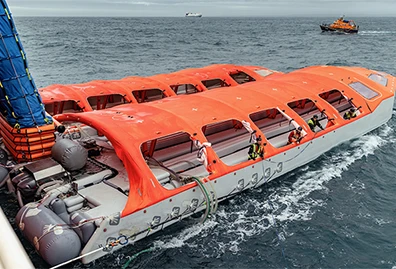Study confirms Seahaven as the future of cruise ship safety, innovation and revenue growth
03/04/25

Survitec, a global leader in Survival Technology, has received independent validation for its Seahaven system, the world’s largest inflatable lifeboat, which signifies an innovative advancement in passenger safety, vessel design, and operational efficiency.
The study, conducted by the naval architecture and marine engineering consultancy Foreship, quantifies the substantial benefits of integrating Seahaven into cruise ship designs, with a focus on space utilisation and cost efficiency. The study also highlights that vessels can experience weight advantages with Seahaven, making the system favourable for both new designs and retrofitting existing ships.
Survitec’s white paper, ‘Seahaven Application Study’, outlines the study’s findings and examines four primary configurations for integrating the Seahaven system. The findings emphasise Seahaven's ability to significantly enhance cruise ship layout and functionality by optimising valuable deck space by eliminating bulky davit-launched lifeboats.
Seahaven occupies a reduced vertical and longitudinal space relative to traditional lifeboat designs, thereby enhancing bridge visibility and minimising vessel overhang. This characteristic is particularly beneficial for vessels manoeuvring through the Panama Canal. The system’s decreased weight compared to conventional lifeboat configurations affords greater flexibility in ship design, which may lead to reduced construction costs for new builds and improved stability for retrofitted vessels.
With this design flexibility, operators can strategically repurpose prime space for additional passenger cabins, expanded public areas, or upgraded leisure and entertainment facilities, ultimately enhancing revenue potential. The white paper outlines opportunities for mid-sized cruise ships, such as converting interior cabins into sought-after balcony cabins. Alternatively, larger vessels can utilise the space savings to introduce additional leisure and entertainment facilities, ultimately enhancing the guest experience.
A capacity analysis was conducted to evaluate the alignment of the Seahaven lifeboat system with various vessel sizes and configurations. This measures how well the optimised Seahaven system matches the maximum persons on board (POB), including passengers and crew. The study also compared Seahaven’s deployment characteristics with traditional lifeboats, focusing on SOLAS requirements for a 20-degree heel deployment. In the case of medium-sized cruise ships, the Seahaven system integrates well with no significant SOLAS deployment issues. Its minimum helical slide length suits most designs, allowing manageable deployment without major modifications.
As a fully automated evacuation system, Seahaven can safely disembark up to 1,060 passengers in under 22 minutes, eliminating the complexities of traditional davit and release-hook mechanisms. By simplifying onboard LSA management, Seahaven reduces maintenance costs and crew training requirements while ensuring compliance with SOLAS regulations. The system has undergone rigorous heavy-weather sea trials, successfully operating in conditions exceeding Beaufort Scale 6, reinforcing its reliability in real-world emergency scenarios.
Claude Sada, Chief Operating Officer at Survitec, said, “Beyond delivering safety performance, Seahaven enables shipowners to optimise their fleets with improved design flexibility, greater operational efficiencies, and enhanced commercial potential.”
The analysis highlights Seahaven's adaptability across multiple deployment configurations, including hybrid solutions integrating Marine Evacuation Systems (MES) and tender lifeboats. This flexibility ensures seamless integration into diverse vessel types, making Seahaven a viable LSA solution for cruise lines looking to future-proof their fleets.
“Since achieving Lloyd’s Register type approval in 2022, Seahaven has set new benchmarks for maritime safety and vessel optimisation. As the industry continues to prioritise regulatory compliance and passenger experience, adopting Seahaven represents a forward-thinking investment in the future of maritime evacuation systems,” added Sada.
This study confirms Seahaven as the next-generation standard for cruise operators seeking innovative LSA solutions to enhance safety and unlock new revenue-generating opportunities.
Download our whitepaper below.

